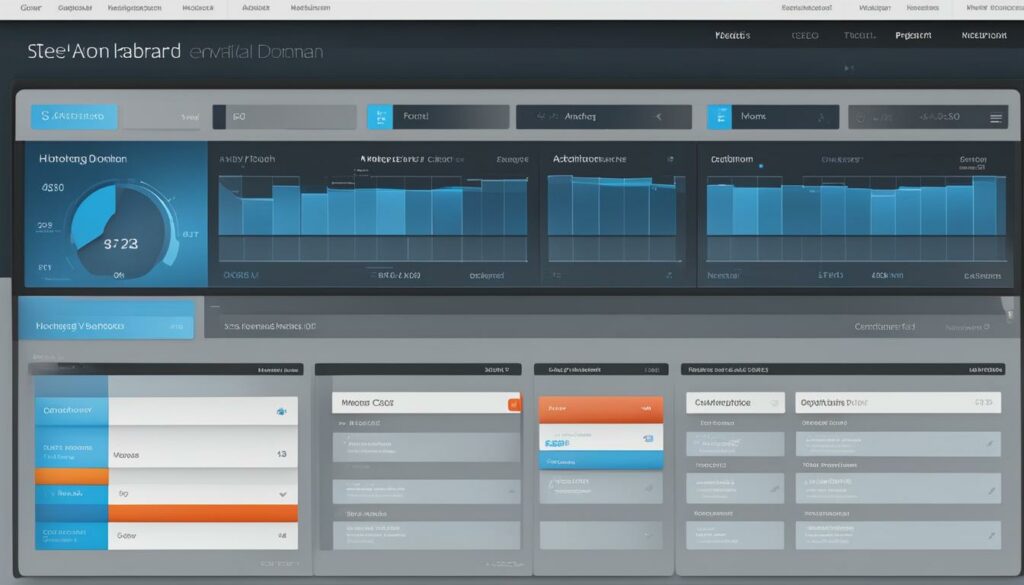Welcome to our guide on understanding serverless architecture in web hosting! In today’s digital landscape, serverless computing has revolutionized the way developers build and deploy applications. Gone are the days of managing servers and infrastructure. With serverless architecture, you can focus on writing code and let the cloud provider handle the rest.
Serverless architecture is based on the concept of function as a service (FaaS), where developers write discrete functions that are triggered by specific events. One popular platform for serverless computing is AWS Lambda, but there are also offerings from Google and Microsoft. This approach offers benefits such as scalability, cost savings, and increased productivity.
Whether you’re new to serverless architecture or looking to deepen your knowledge, this guide will provide you with the insights you need to get started. From understanding the basics to exploring use cases and overcoming challenges, we’ve got you covered. So let’s dive in and explore the world of serverless architecture!
Key Takeaways:
- Serverless architecture allows developers to build and run services without managing infrastructure.
- Function as a Service (FaaS) is a popular type of serverless architecture.
- AWS Lambda is a widely used platform for building serverless applications.
- Serverless architecture offers benefits such as cost savings, scalability, and increased productivity.
- Challenges of serverless architecture include loss of control and security considerations.
- Serverless architecture is suitable for trigger-based events and short-lived tasks.
- Combining serverless functions with containers or VMs is possible in a hybrid infrastructure.
How Serverless Architecture Works
Serverless architecture is a powerful approach to building and deploying applications. In this section, we’ll explore how serverless architecture works and the key concepts involved.
At the heart of serverless architecture are functions. Developers write application code as discrete functions that are triggered by specific events. These events can be anything from an incoming email to an HTTP request.
When a function is invoked, a cloud provider handles its execution. The cloud provider may execute the function on a running server or spin up a new server to handle the request. This allows developers to focus on writing and deploying their application code without having to worry about server provisioning and management.
Serverless architecture allows you to focus on writing code and deploying your applications without worrying about server management.
Now, let’s dive into some of the key concepts in serverless architecture:
Function Invocation
Function invocation refers to the process of triggering a function in response to an event. It’s the mechanism that allows your application to respond to different events and perform specific actions.
Function Duration
The duration of a function is the time it takes for a function to execute from start to finish. It’s an important consideration for performance optimization and cost estimation.
Cold Start
A cold start occurs when a function is invoked for the first time or after a certain period of inactivity. During a cold start, the cloud provider provisions and initializes the necessary resources to execute the function. Cold starts can introduce additional latency, especially for functions with long initialization times.
Concurrency Limit
Concurrency limit refers to the maximum number of function executions that can happen simultaneously. Cloud providers usually set a limit to prevent resource exhaustion and ensure fair usage across different applications.
Timeout
A timeout is the maximum amount of time a function is allowed to run before it’s terminated by the cloud provider. It’s crucial for preventing functions from running indefinitely and causing resource bottlenecks.
Keep in mind that different cloud providers may use different terminology and set unique limits on serverless functions. It’s essential to familiarize yourself with the specific features and limitations of your chosen provider, such as AWS Lambda for Amazon Web Services.
Now that we have a clearer understanding of how serverless architecture works, let’s explore the comparison between serverless and container architecture in the next section.
Serverless Architecture vs. Container Architecture
When it comes to deploying and managing applications, there are two distinct approaches: serverless architecture and container architecture. Each approach offers unique advantages and considerations for developers.
In serverless architecture, the focus is on writing application code, while the cloud provider takes care of server management. This means developers can concentrate on building the core functionality of their applications without having to worry about infrastructure. Scaling is automatic in serverless architecture, allowing applications to handle varying levels of traffic without manual intervention.

In contrast, container architecture provides developers with more control over the underlying operating system and runtime environment. Containers are self-contained units that package an application and its dependencies, making them suitable for high-traffic applications that require precise control over their environment.
Scaling in container architectures typically requires an orchestration platform like Kubernetes. Developers can define the desired number of container instances running their application and Kubernetes handles the scaling process accordingly.
So, how do you decide which approach to choose? It depends on the specific requirements of your application. Serverless architecture is well-suited for trigger-based events, where functions are invoked in response to specific events like incoming emails or HTTP requests. On the other hand, container architecture excels at handling applications with consistently high traffic and when developers require granular control over the environment.
A hybrid approach can also be adopted, where containers or virtual machines are used to handle most requests, and serverless functions are employed for specific tasks or trigger-based events. This way, developers can leverage the advantages of both architectures, combining precise control with scalability and flexibility.
To summarize, serverless architecture allows you to focus on writing application code, while container architecture offers greater control over the runtime environment. Understanding the specific needs of your application and considering factors such as scalability, control, and performance will help you make an informed decision on which architecture to adopt.
Benefits and Challenges of Serverless Architecture
Serverless architecture offers numerous benefits that make it an attractive choice for businesses. By adopting serverless architecture, you can take advantage of the following:
- Cost Savings: With serverless architecture, you only pay for the actual usage of resources, which eliminates the need for upfront infrastructure costs. This cost-effective approach allows businesses to optimize their budget and allocate resources more efficiently.
- Scalability: Serverless architecture offers automatic scalability, allowing your applications to seamlessly handle increased traffic or demands. The cloud provider takes care of scaling resources up or down based on workload fluctuations, ensuring optimal performance.
- Productivity: By offloading server management to the cloud provider, serverless architecture allows developers to focus solely on writing application code. This streamlined process increases development productivity, as developers can quickly deploy and iterate on their code without the overhead of infrastructure management.
However, while serverless architecture provides significant benefits, it also brings forth several challenges that businesses need to consider:
- Loss of Control: With serverless architecture, businesses relinquish control over the underlying software stack and infrastructure. This lack of control can limit customization options and require businesses to rely heavily on the capabilities provided by the cloud provider.
- Security Risks: Running code on shared servers in a serverless environment can introduce potential security risks. Businesses must carefully address and mitigate these risks to ensure the security of their applications and data.
- Performance Impact: Serverless functions can experience latency due to cold starts, which occur when a new instance needs to be initialized. This latency can impact the overall performance of your applications, especially for time-sensitive tasks.
- Integration Testing: Integration testing in a serverless environment can be challenging due to the distributed nature of serverless functions. Proper testing strategies and tools are required to ensure seamless integration between different components of your application.
- Vendor Lock-In: Adopting serverless architecture often involves relying on a single cloud provider’s services and tools. This can result in vendor lock-in, making it challenging to switch providers or migrate to a different architecture in the future.
Despite these challenges, serverless architecture remains an ideal choice for companies looking to minimize time to market and build lightweight, scalable applications. However, it may not be suitable for applications with a large number of continuous, long-running processes that require extensive control and customization.
Take a look at the table below for a comprehensive comparison of the benefits and challenges of serverless architecture:
Serverless Architecture Use Cases
Serverless architecture offers a wide range of use cases, making it a versatile solution for various scenarios. Some common use cases for serverless architecture include:
Trigger-based Tasks:
Serverless architecture is especially well-suited for short-lived tasks and workloads with infrequent or unpredictable traffic. It excels in trigger-based tasks, such as processing user activity that triggers a series of events. For example, when a user uploads an image to a website, a serverless function can be triggered to resize and optimize the image automatically.
Building RESTful APIs:
Another use case for serverless architecture is building RESTful APIs. With serverless functions, developers can easily create API endpoints that respond to incoming HTTP requests. These functions can handle data validation, processing, and integration with other services, providing a scalable and cost-effective solution for API development.
Asynchronous Processing:
Serverless architecture is also ideal for handling asynchronous processing tasks. For example, serverless functions can be used to render product information on an e-commerce website or transcode videos in the background. Asynchronous processing allows applications to offload time-consuming tasks to serverless functions, resulting in improved performance and responsiveness.
Security Checks:
Serverless functions can also be employed for security checks, such as scanning instances for vulnerabilities. By integrating security checks into the serverless architecture, developers can automate the process and ensure that instances are regularly and thoroughly examined for potential security risks.
Continuous Integration and Continuous Delivery (CI/CD):
Serverless architectures can automate many stages in the CI/CD pipeline. Developers can use serverless functions to perform tasks such as running unit tests, deploying application updates, or executing automated build processes. By leveraging the serverless model, CI/CD pipelines become more efficient and scalable.
Hybrid Infrastructure:
In a hybrid infrastructure setup, developers can combine serverless functions with containers or virtual machines to handle different types of requests. For example, containers or virtual machines can handle most requests, while serverless functions are utilized for specific tasks or trigger-based events. This hybrid approach provides flexibility and allows developers to leverage the benefits of both serverless architecture and container architecture.
These are just a few examples of the diverse use cases for serverless architecture. Its versatility and scalability make serverless architecture an increasingly popular choice for modern application development.
Conclusion
Serverless architecture, with its serverless computing approach, offers a host of benefits to developers. It allows for significant cost savings, as you only pay for the resources you use. Scalability becomes effortless, as the cloud provider takes care of automatically scaling your applications based on demand. Additionally, serverless architecture boosts productivity by freeing developers from managing server infrastructure and allowing them to focus solely on writing application code.
However, serverless architecture also comes with its share of challenges. As you relinquish control over the underlying infrastructure, certain security considerations need to be taken into account. There may be potential performance impacts, such as cold starts, which introduce a slight latency when executing functions. Despite these challenges, serverless architecture is an excellent choice for trigger-based tasks, building RESTful APIs, handling asynchronous processing, performing security checks, and automating CI/CD pipelines.
When adopting serverless architecture, it’s crucial to select the right tools for development. Options like Serverless Framework and AWS SAM provide serverless deployment frameworks that streamline the process. Additionally, tools like Datadog help monitor serverless applications effectively. By harnessing the power of serverless computing and using the appropriate tools, developers can simplify deployments and scale applications effortlessly.
FAQ
Q: What is serverless architecture?
A: Serverless architecture is an approach to software design that allows developers to build and run services without managing the underlying infrastructure. It offloads server management to a cloud provider, allowing developers to focus on writing application code.
Q: How does serverless architecture work?
A: Serverless architecture works by allowing developers to write and deploy application code as discrete functions. These functions are triggered by events, such as incoming emails or HTTP requests. When a function is invoked, the cloud provider executes it on a running server or spins up a new server if needed.
Q: What is the difference between serverless architecture and container architecture?
A: In serverless architecture, developers focus on writing application code and rely on a cloud provider to handle server management, while container architecture gives developers control over the underlying operating system and runtime environment. Serverless architecture is better suited for trigger-based events, while containers are suitable for applications with consistently high traffic.
Q: What are the benefits and challenges of serverless architecture?
A: Serverless architecture offers benefits like cost savings, scalability, and increased productivity. However, it also presents challenges such as a loss of control over the underlying software stack, security risks, potential latency introduced by cold starts, and difficulties with integration testing.
Q: What are the use cases for serverless architecture?
A: Serverless architecture is well-suited for short-lived tasks, trigger-based tasks, building RESTful APIs, handling asynchronous processing, performing security checks, and automating stages in the CI/CD pipeline. It can also be used in a hybrid infrastructure alongside containers or virtual machines.
Q: What are some recommended tools for serverless development?
A: Some recommended tools for serverless development include serverless deployment frameworks like Serverless Framework or AWS SAM, as well as serverless monitoring tools like Datadog.












